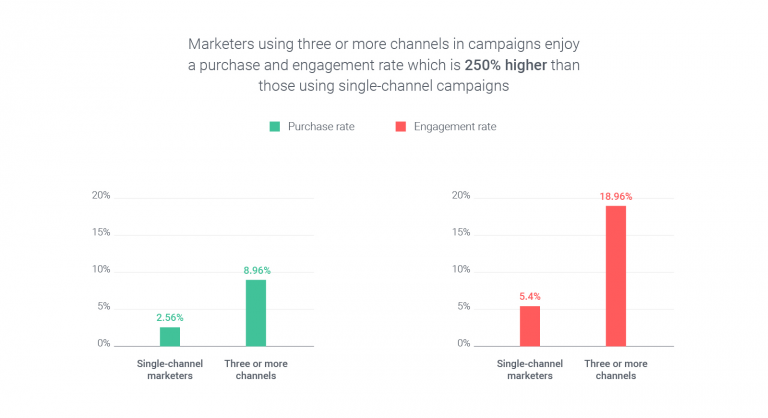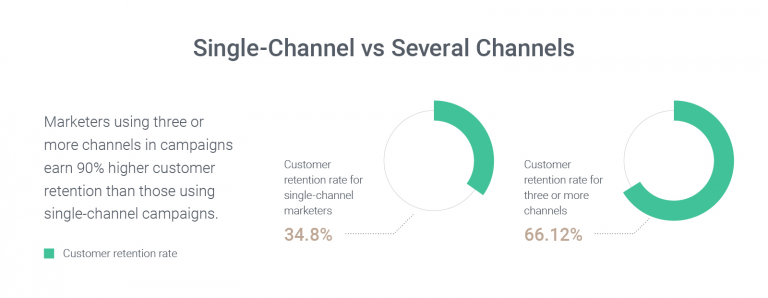Omnichannel marketing automation statistics for 2019
26 Aug 2022Recent study shows advantages of omnichannel marketing automation including 250% higher purchase frequency and 90% higher customer retention rates.
2018 was a huge year for digital marketers. With the implementation of GDPR in the EU and the rising concerns of data privacy across the digital landscape, marketers had to make pivotal changes to the way they communicated with their customers.
But 2018 wasn’t just an impactful year when it comes to data privacy. Many thought the new data regulations would slow digital marketers down. However, that couldn’t be further from reality.
2018 was the year consumers across the world demanded more. Email marketing wasn’t enough for a great customer experience with a brand — and brands rose to that challenge more than ever before.
We pulled these latest omnichannel marketing automation statistics from Omnisend’s Annual Report for 2019.
How omnichannel marketing creates a personalized experience
First, let’s make the distinction between multichannel and omnichannel marketing.
- Multichannel marketing: When a brand reaches out on several channels with the same message in hopes of reaching as many customers as possible.
- Omnichannel marketing: When a brand sends messages to a customer across channels that interact with each other and with the customer, responding to customer needs throughout.
A customer’s needs change rapidly over the course of their customer journey, and a brand’s message to that customer needs to change in response to those needs.
An omnichannel marketing strategy uses channels that respond to and update customer data as they interact with the brand during their journey. So while a customer might receive an email with one offer, the next message they get, regardless of the channel, will change and adapt based on the behavior the customer exhibited when engaging with that email.
Understanding this distinction, we can better grasp the implications of the following statistics.
In this report, Omnisend studied marketers using automation workflows containing three channels or more, all of which would fall under the “omnichannel” category.
Omnichannel statistics: Single vs several channels
What kind of results do marketers get by using more channels in their automation workflows versus those who use just one channel?
The hypothesis would clearly be that marketers who use more channels would be more successful than those who stick to one — say, automated emails.
And indeed, customers who interacted with an omnichannel campaign using three or more channels had higher engagement than those who interacted with email-only campaigns.
When looking at engagement rate based on total engagement per channel, marketers who used more channels had higher engagement across the board.
Engagement rate: 18.96% on omnichannel vs 5.4% on single-channel
Using three or more channels in an automation workflow earned an 18.96% engagement rate, while their single-channel counterparts earned a just 5.4% engagement rate.

Purchase frequency: 250% higher on omnichannel vs single-channel
And engagement rate wasn’t the only statistic affected — purchase rates changed significantly as well.
When interacting with three or more channels, customers bought 250% more frequently than customers who only engaged with only one channel.
Of course, higher purchase rates could potentially be attributed to another variable, such as which channels offer more promotions.
In order to test for that variable, researchers looked at the average order value (AOV) for customers coming from campaigns using three or more channels.
Average order value: 13% more per order on omnichannel vs single-channel
Results showed that customers interacting with campaigns using three or more channels spent 13% more on average per order than those interacting with just one channel.

So we’ve seen that customers purchased more frequently and at higher order values from omnichannel campaigns. But did they stick around?
Customer retention rates: 90% higher for omnichannel vs single-channel
The study also looked at customer retention rates for brands that used three or more channels in their automation workflows compared to those who used only one channel:

Customers who engaged with three or more channels were 90% more likely to come back for another purchase.
Customer retention for these brands came in at 66.12%, compared to 34.8% for single-channel campaigns.
Not only were customers who interacted with more than one channel in a campaign more willing to purchase — they were also more willing to repeat that purchase.
In sum
Omnichannel marketing was once only available to powerhouse ecommerce brands like Amazon. But now, technology has advanced far enough to make this a possibility for anyone, regardless of store size.
From these key statistics on the advantages of omnichannel marketing automation, we can see that customers are ready and responsive to these experiences.
According to this study, the advantages of omnichannel marketing automation include:
- Engagement rate: 18.96% on omnichannel vs 5.4% on single-channel
- Purchase frequency: 250% higher on omnichannel vs single-channel
- Average order value: 13% more per order on omnichannel vs single-channel
- Customer retention rates: 90% higher for omnichannel vs single-channel